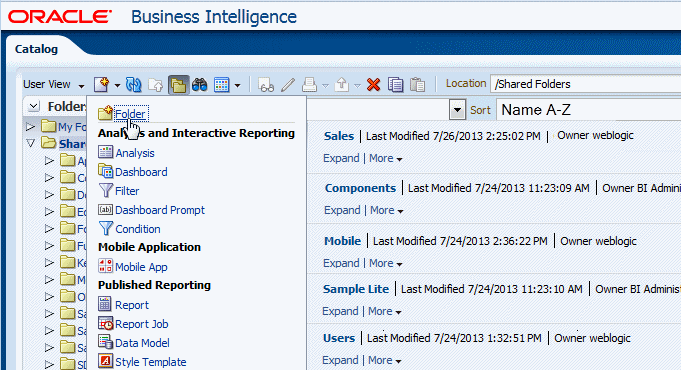Oracle® Business Intelligence Mobile App Designer
Installation Notes
11g Release 1 (11.1.1.7.1)
E48576-03
February 2014
This document describes how to install the Oracle Business Intelligence Mobile App Designer. It includes the following sections:
1 Overview
To install the Oracle Business Intelligence Mobile App Designer, download and apply the required patches into an existing Oracle Business Intelligence Enterprise Edition environment. Complete the postinstallation tasks to enable the BI Mobile App Designer components in your environment.
2 Prerequisites
Ensure that you meet the following requirements before you install or deinstall the patch. Download patches from My Oracle Support at https://support.oracle.com.
-
Oracle Business Intelligence Enterprise Edition version 11.1.1.7.131017 or later.
If you are not already on Oracle Business Intelligence Enterprise Edition version 11.1.1.7.131017, apply the latest patch available. Currently, that is Patch 17886497: Oracle Business Intelligence Enterprise Edition Suite Bundle Patch 11.1.1.7.1401114.
Customers who are upgrading from 11.1.1.6.x or customers who have already performed an in-place upgrade to the latest patch level, ensure that you enable the JBIPS features as described in "Enabling JBIPS Features" in Oracle Fusion Middleware Patching Guide.
-
Download Oracle BI Mobile App Designer patch 17220944 from My Oracle Support.
3 Installing Oracle BI Mobile App Designer
Complete the following tasks to install Oracle BI Mobile App Designer:
3.1 Task 1: Stop the Oracle BIEE System
Stop all of the following components in the order shown:
-
BI System components.
-
On Unix:
Navigate to
prod_mwhome/instances/<instance>/binEnter the following at the command prompt:
./opmnctl stopall -
On Windows:
Navigate to
prod_mwhome\instances\<instance>\binEnter the following at the command prompt:
opmnctl stopall
-
-
Weblogic Managed Servers:
-
On Unix:
Navigate to
prod_mwhome/user_projects/domains/<domain_name>/binEnter the following at the command prompt:
./stopManagedWebLogic.sh bi_server1 -
On Windows:
Navigate to
prod_mwhome\user_projects\domains\<domain_name>\binEnter the following at the command prompt:
stopManagedWebLogic.cmd bi_server1
-
-
WebLogic Administration Server
-
On Unix:
Navigate to
prod_mwhome/user_projects/domains/<domain_name>/binEnter the following at the command prompt:
./stopWebLogic.sh -
On Windows:
Navigate to
prod_mwhome\user_projects\domains\<domain_name>\binEnter the following at the command prompt:
stopWebLogic.cmd -stop
-
3.2 Task 2: Apply Oracle BI Mobile App Designer OPatch
Note:
Standard Oracle Fusion Middleware (FMW) customers must apply this patch to:
-MW_HOME /OracleBI1 (Oracle BI Home)
To apply the OPatch:
-
Unzip the patch zip file into the Oracle BI Home directory.
For example:
-
On Unix you might extract patch 17220944 to
prod_mwhome/Oracle_BI1/17220944 -
On Windows you might extract patch 17220944 to
c:\prod_mwhome\Oracle_BI1\17220944
-
-
Set your current directory to the directory where the patch is located.
For example:
-
On UNIX: If the Oracle BI Home directory is
prod_mwhome/Oracle_BI1, then enter the following:$ cd prod_mwhome/Oracle_BI1 -
On Windows: If the Oracle BI Home directory is
C:\prod_mwhome\Oracle_BI1, then enter the following:cd c:\prod_mwhome\Oracle_BI1
-
-
At the command prompt, set the ORACLE_HOME, PATH, and JAVA_HOME environment variables as appropriate for the operating system.
For example:
-
On Unix if you are using a command shell derived from the C shell, then set the environment variables by entering the following:
setenv ORACLE_HOME $PWD setenv PATH $ORACLE_HOME/bin:$PATH setenv JAVA_HOME $ORACLE_HOME/jdk setenv PATH $JAVA_HOME/bin:$PATH setenv PATH $ORACLE_HOME/OPatch:$PATH
-
On Windows: If the Oracle BI Home directory is C:\prod_mwhome\Oracle_BI1, then set the environment variables by entering the following:
set ORACLE_HOME=C:\prod_mwhome\Oracle_BI1 set PATH=%ORACLE_HOME%\bin;%PATH% set JAVA_HOME=%ORACLE_HOME%\jdk set PATH=%JAVA_HOME%\bin;%PATH% set PATH=%ORACLE_HOME%\OPatch;%PATH%
-
-
At the command prompt, change directory to the extracted patch directory.
For example:
-
On Unix: If you extracted patch 17220944 into
prod_mwhome/Oracle_BI1/17220944then enter the following:
$ cd prod_mwhome/Oracle_BI1/17220944 -
On Windows: If you extracted patch 17220944 into
C:\prod_mwhome\Oracle_BI1\17220944then enter the following:
cd C:\prod_mwhome\Oracle_BI1\17220944
-
-
Apply the patch.
Use the following command to apply the patch to the ORACLE_HOME:
opatch applyWhen OPatch starts, it validates the patch to ensure that there are no conflicts with the software already installed in the ORACLE_HOME.
OPatch categorizes two types of conflicts:
-
Conflicts with a patch already applied to the ORACLE_HOME.
In this case, stop the patch installation, and contact Oracle Support Services.
-
Conflicts with a subset patch already applied to the ORACLE_HOME.
In this case, continue the install as the new patch contains all the fixes from the existing patch in the ORACLE_HOME.
-
4 Postinstallation Steps
After applying the OPatch, perform these steps:
-
Task 2: Update Security Configuration for Oracle BI Mobile App Designer
-
Task 3: Enable BI Mobile App Designer in BI Presentation Services
4.1 Task 1: Deploy Oracle BI Mobile App Designer
Run the WebLogic Configuration Assistant to deploy Oracle BI Mobile App Designer. This step is required only the first time you install the patch.
Start the Oracle Business Intelligence Configuration Assistant from the bin directory in the ORACLE_HOME (default folder name is Oracle_BI1), based on the operating system.
For example:
-
On Unix: Go to
prod_mwhome/Oracle_BI1/common/binand run
./config.sh -
On Windows: Go to
prod_mwhome\Oracle_BI1\common\binand run
config.cmd
Enter the following for the Configuration Assistant screens:
Note:
The bimad Web application must be deployed to the same target as the Analytics web application. The default target is "bi_cluster".
-
On the Welcome screen:
Select Extend an existing WebLogic domain.

-
On the Select a WebLogic Domain Directory screen:
Choose the domain to extend, for example: bifoundation_domain
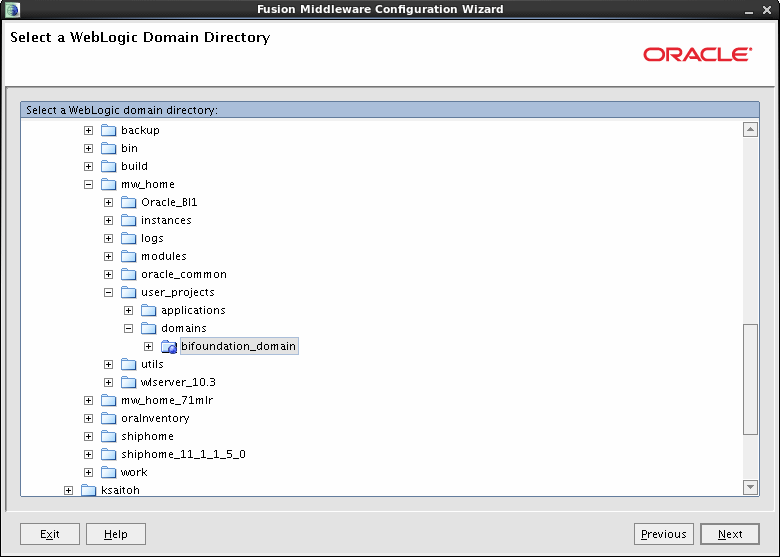
-
On the Select Extension Source screen:
Choose Extend my domain using an existing extension template
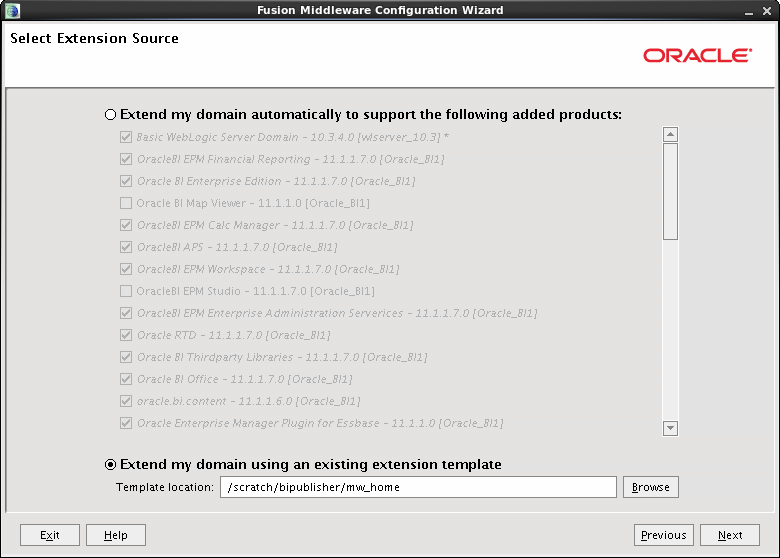
-
Click Browse to locate and select
<mw_home>/Oracle_BI1/common/templates/applications/oracle.bimad_template_11.1.1.jarfor the Template Location.

-
On the Configure JDBC Data Sources screen:
Click Next.

-
On the Test JDBC Data Sources screen:
Click Next.
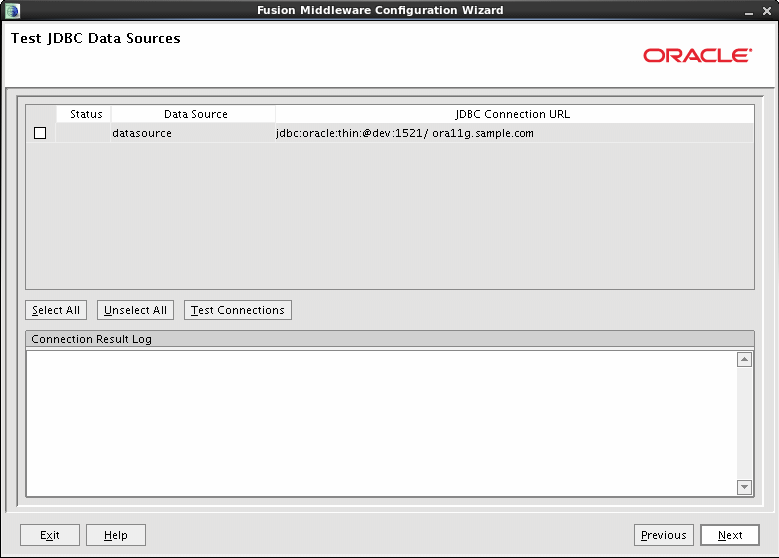
-
On the Configure JDBC Component Schema screen:
Click Next.

-
On the Test JDBC Component Schema screen:
Click Next.
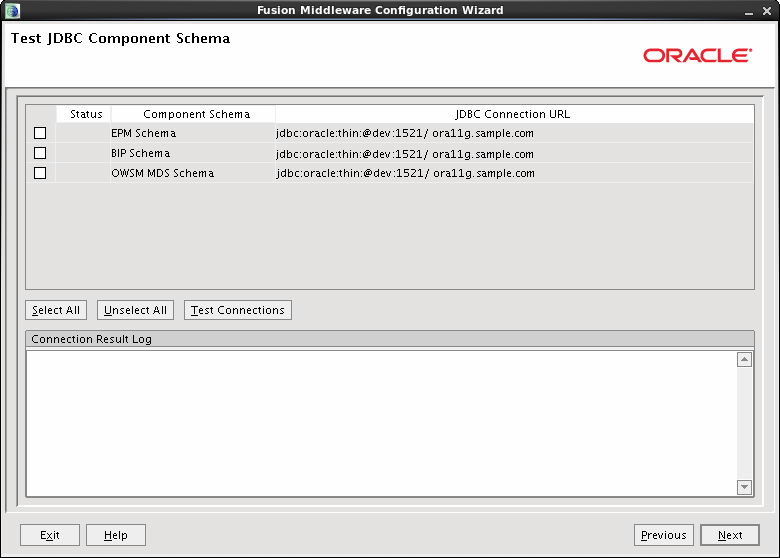
-
On the Select Optional Configuration screen:
Click Next.
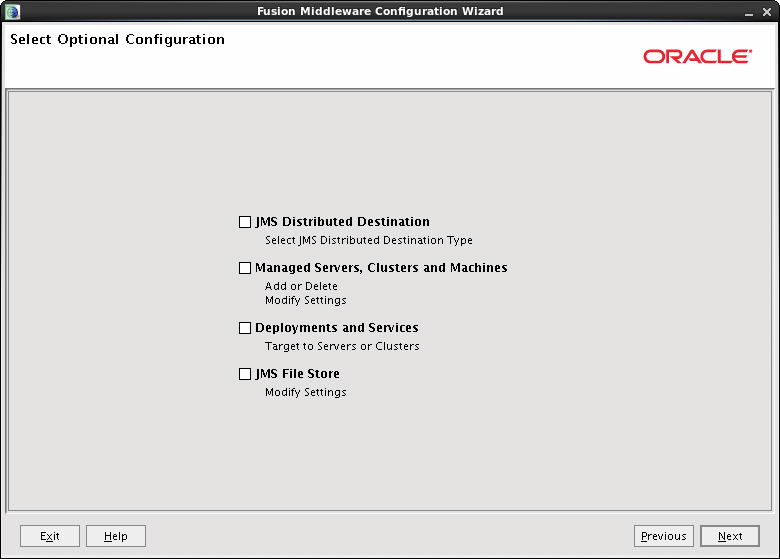
-
On the Configuration Summary screen:
Click Extend.
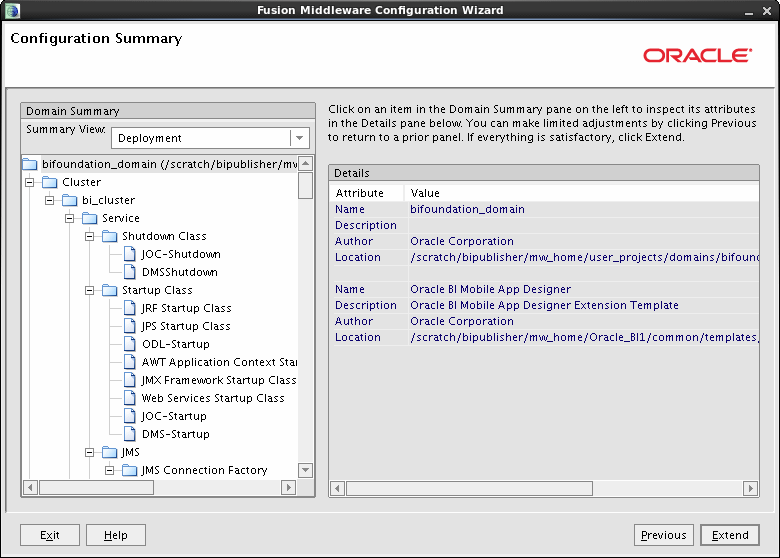
-
On the Extending Domain screen, when Progress shows 100%
click Done to finish.
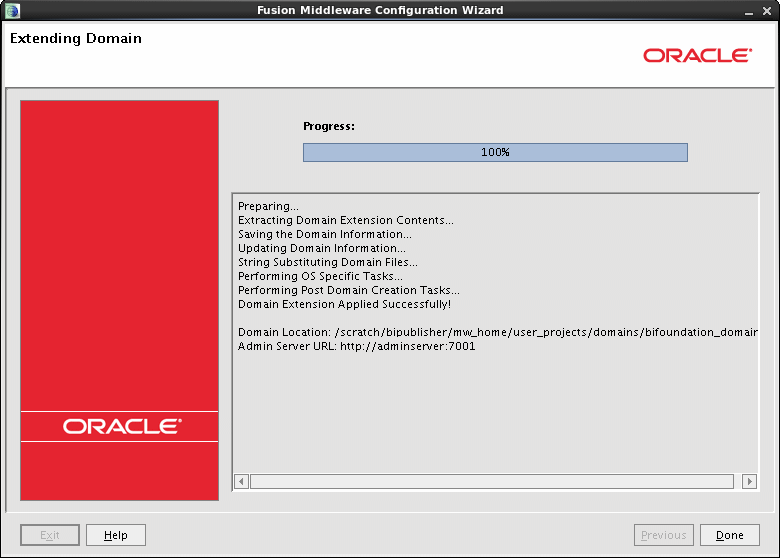
4.2 Task 2: Update Security Configuration for Oracle BI Mobile App Designer
This step executes a Python script to update your system JAZN file (system-jazn-data.xml) with the security grants required for BI Mobile App Designer. This step is required only the first time you apply the patch.
-
Start WebLogic Administration server:
-
On Unix:
Navigate to
prod_mwhome/user_projects/domains/<domain_name>/binEnter the following at the command prompt:
./startWebLogic.sh -
On Windows:
Navigate to
prod_mwhome\user_projects\domains\<domain_name>\binEnter the following at the command prompt:
startWebLogic.cmd -start
-
-
Run WLST script to enable integration with Oracle Fusion Middleware.
-
On Unix: Change directory to the install directory:
cd prod_mwhome/Oracle_BI1/bifoundation/installThen enter:
prod_mwhome/Oracle_BI1/common/bin/wlst.sh addMADCodeGrants.py t3://<hostname>:7001 <WebLogic administrator name>Example:
prod_mwhome/Oracle_BI1/common/bin/wlst.sh addMADCodeGrants.py t3://myserver1:7001 weblogic -
On Windows: Change directory to the install directory:
cd c:\prod_mwhome\Oracle_BI1\bifoundation\installThen enter:
prod_mwhome\Oracle_BI1\common\bin\wlst.cmd addMADCodeGrants.py t3://<hostname>:7001 <WebLogic administrator name>Example:
prod_mwhome\Oracle_BI1\common\bin\wlst.cmd addMADCodeGrants.py t3://myserver1:7001 weblogic
-
4.3 Task 3: Enable BI Mobile App Designer in BI Presentation Services
Enable BI Mobile App Designer in the BI Presentation Services user interface by updating the BI Presentation Services instanceconfig.xml file.
-
Open the configuration file instanceconfig.xml for editing. You can find instanceconfig.xml at:
ORACLE_INSTANCE\config\OracleBIPresentationServicesComponent\coreapplication_obipsnFor example:
\instances\instance1\config\OracleBIPresentationServicesComponent\coreapplication_obips1 -
Add the <EnableMAD> element to the file as shown in the following example:
<ServerInstance> ..... <AdvancedReporting> <EnableMAD>true</EnableMAD> ... </AdvancedReporting> </ServerInstance> -
Save the instanceconfig.xml file.
4.4 Task 4: Start Managed Servers and BI Components
Restart the managed servers and BI components:
-
Start Managed Servers:
-
On Unix, navigate to
prod_mwhome/user_projects/domains/<domain_name>/binand enter the following at the command prompt:
./startManagedWebLogic.sh bi_server1 -
On Windows, navigate to
prod_mwhome\user_projects\domains\<domain_name>\binand enter the following at the command prompt:
startManagedWebLogic.cmd bi_server1
-
-
Start the BI system components by performing the following actions:
-
On Unix, navigate to
prod_mwhome/instances/<instance>/binand enter the following at the command prompt:
./opmnctl startall -
On Windows, navigate to
prod_mwhome\instances\<instance>\binand enter the following at the command prompt:
opmnctl startall
-
4.5 Task 5: Set Up the Apps Library
The Apps Library is where users view, manage, and subscribe to published apps from their mobile devices. From the administrator's perspective, the Apps Library is a folder in the catalog configured to act as the library.
Mobile App Designer also supports publishing apps to a configured Apps Library on a remote instance. For more information about the Apps Library including steps for setting up a remote Apps Library, see "Reference for Administrators" in the Oracle Fusion Middleware User's Guide for Oracle Business Intelligence Mobile App Designer.
Perform the following steps to set up an Apps Library on the local instance:
4.5.1 Create the Apps Library Folder in the Catalog
Create a folder in the catalog under Shared Folders to be the target folder for the Apps Library.
To create a folder in the catalog:
-
Log in to Oracle Business Intelligence.
-
On the Catalog page, select Shared Folders.
-
In the catalog toolbar, click New and select Folder.
-
Enter the folder name and click OK, as shown in Figure 1.
-
Set Permissions on the Apps Library folder. App designers that will be publishing apps to the folder must have Write permissions. App consumers that will be viewing apps in the library must have Read permissions.
4.5.2 Set Up the Configuration File
To register the folder in the catalog to act as the Apps Library, add a property entry to the xmlp-server-config.xml configuration file.
To set up the configuration file:
-
Open the
xmlp-server-config.xmlfile. It is located under<DOMAIN_HOME>/config/bipublisher/repository/Admin/Configuration. -
Add the following property to
xmlp-server-config.xml:Property:
APPS_LIBRARY_FOLDER_LOCALDescription: Specifies the folder in the catalog to act as the Apps Library. Enter the path to the folder under Shared Folders that you created in the previous step (do not include "Shared Folders" in the path).
Sample Configuration File Entry:
<property name="APPS_LIBRARY_FOLDER_LOCAL" value="/Apps Library"/>
-
Restart the
bimad(BI Mobile App Designer) application from the WebLogic Server Administration Console.
5 Validating the Install
To validate the install, log in to Oracle Business Intelligence: http://<hostname>:<port_number>/analytics
On the home page, verify that Mobile Application is an option from the Create menu.
If you do not see the Mobile Application option, see Troubleshooting.
6 Uninstalling Mobile App Designer
If you experience any problems after installing this patch, remove the patch as follows:
Prerequisite: Ensure to follow the same prerequisites when uninstalling a patch. This includes setting up any environment variables such as ORACLE_HOME and verifying the OUI inventory before uninstalling.
6.1 Task 1: Delete the Mobile App Designer application from the WebLogic Administration Console
To delete the Mobile App Designer application:
-
In a browser, navigate to the WebLogic Administration Console.
-
Click Lock & Edit in the Change Center.
-
Click Deployments on the left pane under Domain Structure.
-
On the Deployments table select the bimad application.
-
Click Delete at the top of the table.
-
Click Release Configuration in the Change Center.
6.2 Task 2: Remove Security Configuration
To back out the updates to the system JAZN file (system-jazn-data.xml):
-
Start WebLogic Administration server:
-
On Unix:
Navigate to
prod_mwhome/user_projects/domains/<domain_name>/binEnter the following at the command prompt:
./startWebLogic.sh -
On Windows: Go to
prod_mwhome\Oracle_BI1\common\binand run
config.cmd
-
-
Run WLST script to back out the grants added for Mobile App Designer:
-
On Unix:
Change directory to the install directory:
cd prod_mwhome/Oracle_BI1/bifoundation/installThen enter:
prod_mwhome/Oracle_BI1/common/bin/wlst.sh removeMADCodeGrants.py t3://<hostname>:7001 <WebLogic administrator name>Example:
prod_mwhome/Oracle_BI1/common/bin/wlst.sh removeMADCodeGrants.py t3://myserver1:7001 weblogic -
On Windows:
On Windows: Change directory to the install directory:
cd c:\prod_mwhome\Oracle_BI1\bifoundation\installThen enter:
prod_mwhome\Oracle_BI1\common\bin\wlst.cmd removeMADCodeGrants.py t3://<hostname>:7001 <WebLogic administrator name>Example:
prod_mwhome\Oracle_BI1\common\bin\wlst.cmd removeMADCodeGrants.py t3://myserver1:7001 weblogic
-
-
Start Managed Servers:
-
On Unix, navigate to
prod_mwhome/user_projects/domains/<domain_name>/binand enter the following at the command prompt:
./startManagedWebLogic.sh bi_server1 -
On Windows, navigate to
prod_mwhome\user_projects\domains\<domain_name>\binand enter the following at the command prompt:
startManagedWebLogic.cmd bi_server1
-
-
Start the BI system components by performing the following actions:
-
On Unix, navigate to
prod_mwhome/instances/<instance>/binand enter the following at the command prompt:
./opmnctl startall -
On Windows, navigate to
prod_mwhome\instances\<instance>\binand enter the following at the command prompt:
opmnctl startall
-
6.3 Task 3: Run OPatch to uninstall the patch
Use the OPatch command to uninstall the Oracle BI Mobile App Designer patch.
-
Change to the directory where the patch was unzipped.
-
Run the OPatch command:
opatch rollback -id 17220944
7 Troubleshooting
-
Mobile App Designer Option Not Available from Oracle Business Intelligence Home Page
-
Mobile App Designer Options Disappear from BI Home Page After Upgrading to a BIEE Bundle Patch
-
Why do I get the following patch conflict error message when running OPatch?
-
Why do I get the OUI-67078 warning message when applying OPatch?
7.1 The bimad Application Does Not Start
Following are two possible causes for the bimad application failing to start after installation and deployment:
7.1.1 The bimad Application Is Not Deployed to Same Target as Analytics
The bimad Web application must be deployed to the same target as the Analytics web application. The default target is "bi_cluster".
If you did not deploy the bimad application to the same target as the Analytics web application, change the deployment as follows:
-
In a browser, navigate to the WebLogic Administration Console.
-
Click Lock & Edit in the Change Center.
-
Click Deployments on the left pane under Domain Structure.
-
On the Deployments table select the bimad application.
-
Select the Targets tab.
-
Click Change Targets and update the target server.
-
Click Release Configuration in the Change Center.
7.1.2 Oracle BI JBIPS Is Not Deployed
If the bimad application does not start and you see this error:
[Extension-Name: oracle.bi.jbips.commons, exact-match: false], [Extension-Name: oracle.bi.jbips.soap, exact-match: false]
You must deploy Oracle BI JBIPS 11.1.1.7.0.
Follow the steps in the section "Enabling JBIPS Features for the Smartview Client" under "Post-Patching Tasks If Your Starting Point is Release 11.1.1.6.0," in the Oracle Fusion Middleware Patching Guide.
7.2 Mobile App Designer Option Not Available from Oracle Business Intelligence Home Page
If you log in to the Oracle Business Intelligence Home page and do not see the Mobile App Designer option, ensure that you followed the postinstall step: Section 4.3, "Task 3: Enable BI Mobile App Designer in BI Presentation Services."
7.3 Log In Required When Mobile App Designer Is Opened
If you are prompted for login credentials when you access Mobile App Designer, then the code grants were not successfully added to the system JAZN file.
To validate the code grants:
-
Start WebLogic Administration server:
On Unix:
Navigate to
prod_mwhome/user_projects/domains/<domain_name>/binEnter the following at the command prompt:
./startWebLogic.sh -
Run WLST script to validate the code grants for Mobile App Designer:
cd prod_mwhome/Oracle_BI1/bifoundation/installprod_mwhome/Oracle_BI1/common/bin/wlst.sh validateMADApplication.py t3://<hostname>:7001 <WebLogic administrator name>Example:
prod_mwhome/Oracle_BI1/common/bin/wlst.sh validateMADApplication.py t3://myserver1:7001 weblogic
If the validation script returns: "BI Mobile App Designer deployment not found. Please double check the installation process."
Repeat Task 2: Update Security Configuration for Oracle BI Mobile App Designer.
If the validation script returns: "BI Mobile App Designer deployment found."
Contact Oracle Support Services.
7.4 The addMADCodeGrants.py Script Fails
If the addMADCodeGrants.py script fails ensure that you are using wlst.sh under
prod_mwhome/Oracle_BI1/common/bin
Do NOT use
prod_mwhome/wlserver_10.3/common/bin
7.5 Mobile App Designer Options Disappear from BI Home Page After Upgrading to a BIEE Bundle Patch
If you installed Oracle BI Mobile App Designer to your 11.1.1.7.1 environment and then upgrade to a later Oracle BIEE Bundle Patch (such as 11.1.1.7.140114), ensure that <EnableMAD> is set to "true" in the instanceconfig.xml, as described in Section 4.3, "Task 3: Enable BI Mobile App Designer in BI Presentation Services."
7.6 Why do I get the following patch conflict error message when running OPatch?
If the patch that you apply conflicts with a previously applied patch, you may receive the following error message when running OPatch:
Patch(es) <PreviousPatch#> conflict with the patch currently being installed (<NewPatch#>).
If you continue, patch(es) <PreviousPatch#> will be rolled back and the new patch (<NewPatch#>) will be installed.
If a merge of the new patch (<NewPatch#>) and the conflicting patch(es) (<PreviousPatch#>) is required, contact Oracle Support Services and request a Merged patch.
This error is returned when one patch attempts to update a previously patched file. When this conflict happens, you can either (1) roll back the previous patch and use the new patch (this action might be appropriate if the previous patch was not critical) or (2) request a ”merged patch” consisting of the new patch and the patch that it conflicts with. To request a merged patch, contact your Oracle Support representative.
7.7 Why do I get the OUI-67078 warning message when applying OPatch?
This warning means that the patch being applied is a superset of a patch already on the deployment and the existing patch will be rolled back. The following snippet shows the context of this warning.
The following warnings have occurred during OPatch execution: 1) OUI-67078:Interim patch [77777777] is a superset of the patch(es) [77777777] in OH C:\Oracle\Middleware\EPM_ORACLE_HOME ----------------------------------------------------------------------------------- OPatch Session completed with warnings.
8 Known Issues
For the most current list of known issues and workarounds for this release, see the Oracle Business Intelligence Mobile App Designer Release Notes on the Oracle Technology Network at
http://www.oracle.com/technetwork/middleware/bi-foundation/bi-foundation/release-note-1990156.html
9 Documentation Accessibility
For information about Oracle's commitment to accessibility, visit the Oracle Accessibility Program website at http://www.oracle.com/pls/topic/lookup?ctx=acc&id=docacc.
Oracle customers have access to electronic support through My Oracle Support. For information, visit http://www.oracle.com/pls/topic/lookup?ctx=acc&id=info or visit http://www.oracle.com/pls/topic/lookup?ctx=acc&id=trs if you are hearing impaired.
Installation Notes, 11g Release 1 (11.1.1.7.1)
E48576-03
Copyright © 2014, Oracle and/or its affiliates. All rights reserved.
This software and related documentation are provided under a license agreement containing restrictions on use and disclosure and are protected by intellectual property laws. Except as expressly permitted in your license agreement or allowed by law, you may not use, copy, reproduce, translate, broadcast, modify, license, transmit, distribute, exhibit, perform, publish, or display any part, in any form, or by any means. Reverse engineering, disassembly, or decompilation of this software, unless required by law for interoperability, is prohibited.
The information contained herein is subject to change without notice and is not warranted to be error-free. If you find any errors, please report them to us in writing.
If this is software or related documentation that is delivered to the U.S. Government or anyone licensing it on behalf of the U.S. Government, the following notice is applicable:
U.S. GOVERNMENT END USERS: Oracle programs, including any operating system, integrated software, any programs installed on the hardware, and/or documentation, delivered to U.S. Government end users are "commercial computer software" pursuant to the applicable Federal Acquisition Regulation and agency-specific supplemental regulations. As such, use, duplication, disclosure, modification, and adaptation of the programs, including any operating system, integrated software, any programs installed on the hardware, and/or documentation, shall be subject to license terms and license restrictions applicable to the programs. No other rights are granted to the U.S. Government.
This software or hardware is developed for general use in a variety of information management applications. It is not developed or intended for use in any inherently dangerous applications, including applications that may create a risk of personal injury. If you use this software or hardware in dangerous applications, then you shall be responsible to take all appropriate failsafe, backup, redundancy, and other measures to ensure its safe use. Oracle Corporation and its affiliates disclaim any liability for any damages caused by use of this software or hardware in dangerous applications.
Oracle and Java are registered trademarks of Oracle and/or its affiliates. Other names may be trademarks of their respective owners.
Intel and Intel Xeon are trademarks or registered trademarks of Intel Corporation. All SPARC trademarks are used under license and are trademarks or registered trademarks of SPARC International, Inc. AMD, Opteron, the AMD logo, and the AMD Opteron logo are trademarks or registered trademarks of Advanced Micro Devices. UNIX is a registered trademark of The Open Group.
This software or hardware and documentation may provide access to or information on content, products, and services from third parties. Oracle Corporation and its affiliates are not responsible for and expressly disclaim all warranties of any kind with respect to third-party content, products, and services. Oracle Corporation and its affiliates will not be responsible for any loss, costs, or damages incurred due to your access to or use of third-party content, products, or services.
